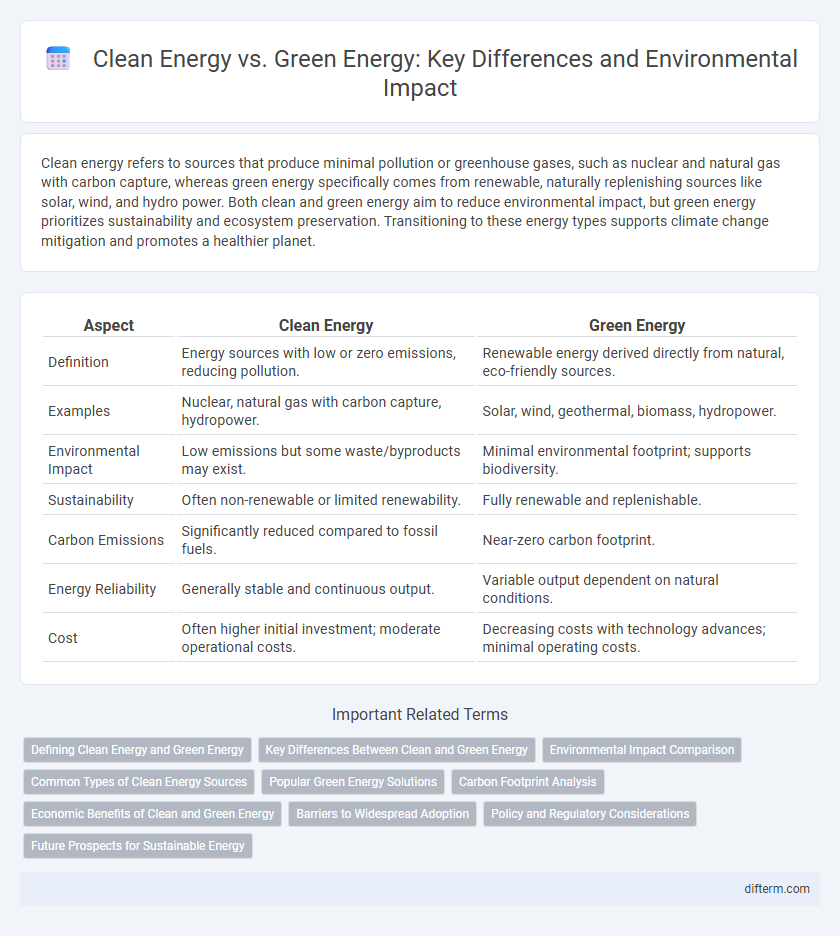Clean energy refers to sources that produce minimal pollution or greenhouse gases, such as nuclear and natural gas with carbon capture, whereas green energy specifically comes from renewable, naturally replenishing sources like solar, wind, and hydro power. Both clean and green energy aim to reduce environmental impact, but green energy prioritizes sustainability and ecosystem preservation. Transitioning to these energy types supports climate change mitigation and promotes a healthier planet.
Table of Comparison
| Aspect | Clean Energy | Green Energy |
|---|---|---|
| Definition | Energy sources with low or zero emissions, reducing pollution. | Renewable energy derived directly from natural, eco-friendly sources. |
| Examples | Nuclear, natural gas with carbon capture, hydropower. | Solar, wind, geothermal, biomass, hydropower. |
| Environmental Impact | Low emissions but some waste/byproducts may exist. | Minimal environmental footprint; supports biodiversity. |
| Sustainability | Often non-renewable or limited renewability. | Fully renewable and replenishable. |
| Carbon Emissions | Significantly reduced compared to fossil fuels. | Near-zero carbon footprint. |
| Energy Reliability | Generally stable and continuous output. | Variable output dependent on natural conditions. |
| Cost | Often higher initial investment; moderate operational costs. | Decreasing costs with technology advances; minimal operating costs. |
Defining Clean Energy and Green Energy
Clean energy refers to energy sources that produce little to no harmful emissions or pollutants, such as solar, wind, hydroelectric, and nuclear power. Green energy is a subset of clean energy, emphasizing renewable sources that are naturally replenished and environmentally sustainable, including solar, wind, and biomass. The key distinction lies in green energy's focus on renewability and minimal environmental impact, while clean energy broadly includes any low-emission technology.
Key Differences Between Clean and Green Energy
Clean energy primarily refers to energy sources that emit little to no pollutants during production, such as natural gas with carbon capture and nuclear power, whereas green energy specifically denotes renewable sources like solar, wind, and hydropower that have minimal environmental impact throughout their lifecycle. Green energy is a subset of clean energy, emphasizing sustainability and ecological preservation, while clean energy includes both renewable and low-emission non-renewable options. Understanding these distinctions is crucial for developing effective policies targeting carbon reduction and environmental protection.
Environmental Impact Comparison
Clean energy primarily focuses on reducing carbon emissions by utilizing renewable sources like solar, wind, and hydro power, which significantly lowers greenhouse gas output compared to fossil fuels. Green energy, while also renewable, emphasizes sustainability by ensuring minimal environmental disruption, including preserving biodiversity and reducing water usage. Both clean and green energy contribute to mitigating climate change, but green energy generally offers a more comprehensive approach to environmental conservation and ecosystem protection.
Common Types of Clean Energy Sources
Clean energy sources primarily include solar, wind, hydroelectric, and geothermal power, all of which generate electricity with minimal greenhouse gas emissions. Green energy, a subset of clean energy, emphasizes sustainability and environmental friendliness, often highlighting solar and wind as the flagship technologies. These renewable sources play a critical role in reducing dependence on fossil fuels and mitigating climate change impacts.
Popular Green Energy Solutions
Popular green energy solutions encompass solar power, wind energy, and hydropower, all of which harness natural processes to produce sustainable electricity. These technologies reduce greenhouse gas emissions and dependence on fossil fuels, contributing significantly to climate change mitigation. Implementing green energy systems promotes environmental health by preserving ecosystems and decreasing air and water pollution.
Carbon Footprint Analysis
Clean energy sources, such as nuclear and hydropower, produce minimal direct carbon emissions during operation, resulting in a lower carbon footprint compared to fossil fuels. Green energy, including solar, wind, and biomass, emphasizes renewable resources with a focus on sustainability and minimal environmental impact throughout the lifecycle. Carbon footprint analysis reveals that while both clean and green energy reduce greenhouse gas emissions, green energy typically offers greater long-term benefits by promoting ecosystem health and resource renewability.
Economic Benefits of Clean and Green Energy
Clean energy technologies such as solar, wind, and hydroelectric power create significant economic benefits by generating millions of jobs worldwide, reducing operational costs, and minimizing reliance on imported fuels. Green energy investments stimulate local economies through the development of infrastructure and innovation, attracting capital and fostering energy independence. Transitioning to clean and green energy sources also lowers public health expenditure by reducing pollution-related illnesses and boosting long-term economic resilience.
Barriers to Widespread Adoption
Barriers to widespread adoption of clean energy and green energy include high initial investment costs, limited infrastructure, and regulatory challenges that hinder large-scale implementation. Variability in energy generation from renewable sources like solar and wind requires advanced storage solutions to ensure grid reliability and consistent supply. Public awareness and policy incentives remain critical to overcoming economic and technical obstacles essential for expanding clean and green energy usage globally.
Policy and Regulatory Considerations
Clean energy policies primarily focus on reducing carbon emissions through technologies like nuclear and natural gas with carbon capture, while green energy regulations emphasize renewable sources such as solar, wind, and hydroelectric power driven by sustainability goals. Regulatory frameworks often incentivize green energy adoption via subsidies, tax credits, and renewable portfolio standards, whereas clean energy policies may include stricter emission limits and innovation grants for low-carbon technologies. Understanding these distinctions is critical for shaping effective environmental legislation that balances economic growth with climate commitments.
Future Prospects for Sustainable Energy
Clean energy, derived from sources like nuclear and natural gas with lower emissions, contrasts with green energy, which exclusively includes renewable sources such as solar, wind, and hydropower. Future prospects for sustainable energy emphasize expanding green energy technologies due to their minimal environmental impact and infinite resource availability. Innovations in energy storage, grid integration, and policy incentives are driving the global transition towards predominantly green energy systems for a sustainable future.
clean energy vs green energy Infographic

 difterm.com
difterm.com